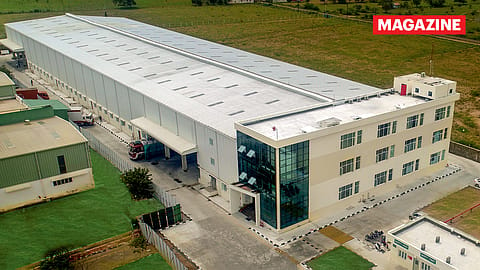Can Hindustan Foods outpace the FMCG slump with its de-risked growth model?
Despite the consumption slowdown, contract manufacturer Hindustan Foods finds itself in a strong position because of its smart strategies.

This story belongs to the Fortune India Magazine May 2025 issue.
OVER THE PAST couple of years, the FMCG segment has been a difficult space to be in for businesses, as domestic consumption has been on shaky ground because of reasons such as high inflation, high interest rates, and stagnant wages, among others.
However, wading through these challenges with moves like strategic diversification, and some element of “serendipity” — as the management prefers to put it — contract manufacturing firm Hindustan Foods Ltd (HFL) has come out with flying colours. The company has registered robust revenue and profitability growth, claiming the 18th spot in Fortune India’s maiden 100 Emerging Stars list. HFL registered a 25.10% CAGR in net sales between FY22 and FY24, while clocking a 35.66% CAGR in net profit.
With its presence in F&B, personal care, health and wellness, beauty and make-up, footwear, and insecticides, among others, HFL’s client list includes top brands like Hindustan Unilever Ltd, Reckitt Benckiser India, Knorr India, Kwality Wall’s, Paper Boat, and Hush Puppies, to name a few. Set up in 1988 as a nutritional food JV between Goa’s Dempo group and Glaxo India, HFL was taken over by Vanity Case Group in 2013, spreading its wings across FMCG categories. Today, it has 36 factories across India.
Growth drivers
HFL’s focus on de-risking and strategic diversification, with forays into new product categories, have been key growth drivers. It believes disruptions such as GST, Covid-19, the Russia-Ukraine war, the subsequent rise in prices, and the tariff war, worked as tailwinds, as they accentuated the need for a resilient supply chain for its clients — global conglomerates.
But challenges like slowing consumption persisted before and after the pandemic. “Most of our customers started shelving capital expenditure and capacity creation. We were forced to look at new categories. And then serendipity played a role,” says MD & CEO Sameer Kothari, referring to HFL’s entry into beverages, shoes, and ice cream.
HFL entered the beverages segment in 2019 with the acquisition of ATC Beverages, and this was followed by two tough years, says the MD & CEO. “Later, rising temperatures, longer summers, and growing electrification led to a… [rise in] the consumption of beverages… We kind of rode that wave,” Kothari tells Fortune India.
More Stories from this Issue
The ice cream story played out similarly. “We set up the ice cream facility about three years ago. Again, electrification and climate change led to a tremendous increase in the overall ice cream market,” adding that HFL will set up two more ice cream factories.
HFL says the ice cream sector is undergoing multiple structural changes with the advent of quick commerce. For instance, ice cream is becoming an all-weather snack. Plus, more PE funding is coming to startups in the space. Another trend, says HFL, is niche product propositions — think flavoured or sugar-free ice cream.
HFL is also looking at backward integration to enhance revenue share from the vertical. “We are looking to build an ice cream stick plant, which will supply the sticks to ice cream makers,” says Manoj Patani, president, ice cream business.
Diversification into shoes and wellness has also rewarded HFL well. “Because of the developments on the tariff front, we believe there could be a phenomenal potential to increase the contract manufacturing business in shoes,” says Kothari. Since the work is labour-intensive, tech and automation cannot substitute for this. “Any kind of shift from China, Vietnam, and even Bangladesh should benefit India,” he says.
(INR CR)
In fact, active participation across segments cushions HFL from cyclical risks and leads to a diversified revenue stream. “We do not expect everything to do well at the same time. Nor do we expect everything to go down at the same time… [this] ensures that we have a steady stream of revenue,” says Sanjay Sehgal, president, healthcare & wellness.
De-risking is, in fact, the core philosophy of the management. “The emphasis on de-risking has been ingrained in our company. We have looked at de-risking by way of locations, customers, and product categories, as even when product categories are the same, consumer behaviour changes very quickly,” says Kothari.
HFL believes the model of decentralised operations — having multiple factories across the country — works well in India, as it enables one to hedge one’s bets. And while it is too early to assess the impact of the tariff war, HFL says opportunities exist. For instance, besides footwear, there is a big opportunity in the beauty and FMCG space. HFL expects its customers, especially in Europe and the U.S., to realign their supply chains. But there are challenges. “The… entire ecosystem needs to be developed, including packaging, graphics, decoration... this will take a year or so, but I think you will see some action coming into the beauty segment in terms of more personal care products getting exported from India,” says Kothari.
HFL, with its diversified portfolio and revenue mix, has strategically placed itself in a position of strength, as is evident from the numbers that it has been posting over the past couple of years. The bets on new product offerings have paid off in the past, and the future growth visibility looks intact even in testing times like these.